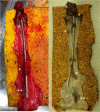Macro- and microscopic changes in veins with short-term central venous catheters: an observational autopsy study
- PMID: 38166620
- PMCID: PMC10759750
- DOI: 10.1186/s12871-023-02380-x
Macro- and microscopic changes in veins with short-term central venous catheters: an observational autopsy study
Abstract
Background: Centrally inserted central catheters (CICCs) are indispensable in modern healthcare, but unfortunately, come with complications. Catheter-related thrombosis is a well-known complication reported to occur in 5-30% of patients with CICC. There is a paucity of studies that report the incidence of catheter-related thrombosis after the introduction of real-time ultrasound insertion guidance as clinical practice. This study aimed to demonstrate any pathological macro- or microscopic changes in the vein wall associated with CICCs.
Methods: The study was approved by the Swedish Ethical Review Authority and was conducted at a large university hospital. The study included 12 patients with a short-term CICC who were subject to autopsies. Vessels with inserted catheters were macroscopically and microscopically examined.
Results: In total, seven female and five male patients with a median age of 70 (interquartile range 63-76) were included. With one exception, all patients received routine thromboprophylaxis throughout the period with CICC. Most inserted CICCs were 9.5 French (54%) and were inserted in the internal jugular vein (92%). The median time with CICC was seven days (interquartile range 1.8-20). At autopsy, thrombi were observed in all cases (100%), macroscopically and microscopically, attached to the distal portion of the CICC and/or the adjacent vessel wall. Inflammatory changes in the vessel walls were seen in all cases, and varying degrees of fibrosis were demonstrated in eight cases (67%).
Conclusions: This autopsy study demonstrated that catheter-related thrombus formation with adjacent inflammatory and fibrotic vessel wall thickening was very common, despite a limited period of catheter use. The consequences of these findings are important, as thrombi may cause pulmonary embolism and possibly lead to catheter-related infections, and since inflammatory and fibrotic vessel wall thickening may evolve into chronic venous stenosis. Furthermore, the findings are a cause of concern, as CICCs are indispensable in modern healthcare and complications may be masked by the general disease that was the indication for CICC insertion.
Keywords: Central venous catheter thrombosis; Central venous catheterization; Complications; Vascular Endothelium; Vascular injury.
© 2023. The Author(s).
Conflict of interest statement
The authors declare no competing interests.
Figures


Similar articles
-
Safe central venous catheters for esophageal cancer treatment.J Med Invest. 2020;67(3.4):298-303. doi: 10.2152/jmi.67.298. J Med Invest. 2020. PMID: 33148905
-
Incidence of catheter-related thrombosis in acute leukemia patients: a comparative, retrospective study of the safety of peripherally inserted vs. centrally inserted central venous catheters.Ann Hematol. 2016 Dec;95(12):2057-2064. doi: 10.1007/s00277-016-2798-4. Epub 2016 Aug 20. Ann Hematol. 2016. PMID: 27542955
-
Upper body central venous catheters in pediatric cardiac surgery.Paediatr Anaesth. 2013 Nov;23(11):980-8. doi: 10.1111/pan.12261. Epub 2013 Sep 19. Paediatr Anaesth. 2013. PMID: 24088201
-
Peripherally inserted central catheters inserted with current best practices have low deep vein thrombosis and central line-associated bloodstream infection risk compared with centrally inserted central catheters: A contemporary meta-analysis.J Vasc Access. 2021 Jan;22(1):9-25. doi: 10.1177/1129729820916113. Epub 2020 May 1. J Vasc Access. 2021. PMID: 32356479
-
Peripherally inserted central catheter-related thrombosis rate in modern vascular access era-when insertion technique matters: A systematic review and meta-analysis.J Vasc Access. 2020 Jan;21(1):45-54. doi: 10.1177/1129729819852203. Epub 2019 Jun 10. J Vasc Access. 2020. PMID: 31177939
Cited by
-
Evaluating the Characteristics of the Totally Implantable Venous Access Device in Cancer Patients Using Fluorodeoxyglucose-PET/CT in the Absence of Suspected Catheter-Related Infections.Cureus. 2025 Feb 6;17(2):e78621. doi: 10.7759/cureus.78621. eCollection 2025 Feb. Cureus. 2025. PMID: 40062140 Free PMC article.
-
Assessing infection related to short-term central venous catheters in the perioperative setting.Sci Rep. 2025 Jan 10;15(1):1642. doi: 10.1038/s41598-025-85836-z. Sci Rep. 2025. PMID: 39794468 Free PMC article.
-
Contact activation of coagulation in newly inserted indwelling catheters.Sci Rep. 2025 Jun 3;15(1):19378. doi: 10.1038/s41598-025-04181-3. Sci Rep. 2025. PMID: 40461568 Free PMC article.
References
Publication types
MeSH terms
Substances
Grants and funding
LinkOut - more resources
Full Text Sources
Medical

